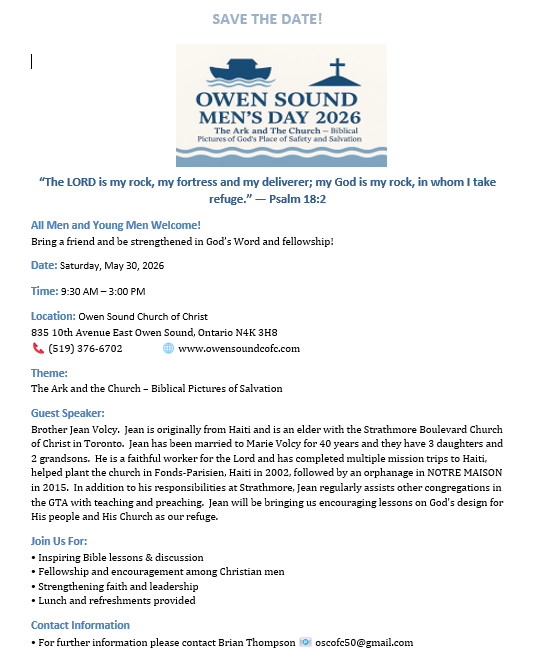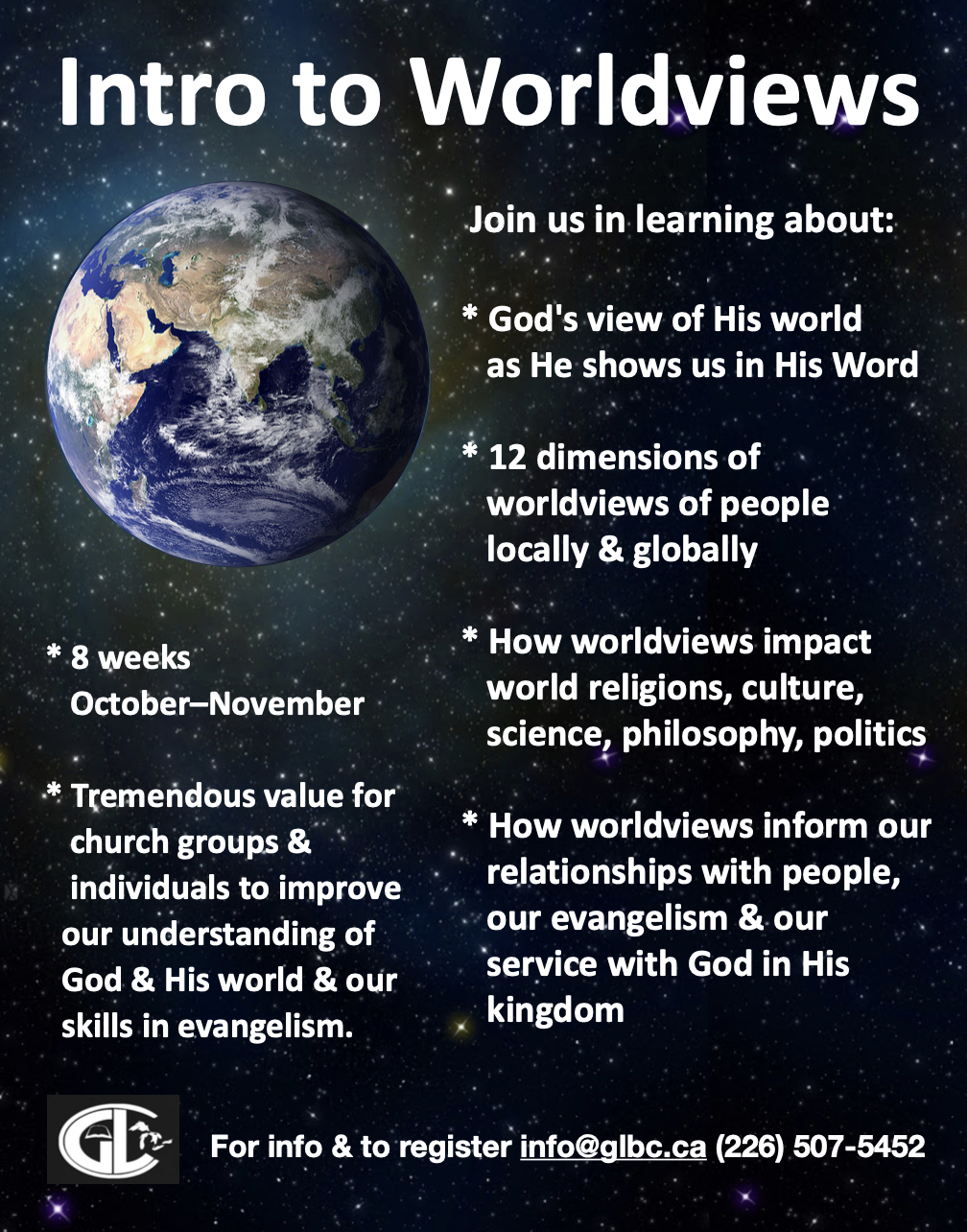As is evident by the number of studies that have been conducted concerning the work of men and women in the kingdom of God, this is an important and timely topic to discuss in every generation. The nature and work of men and women impacts our humanity, our sexual identities, our marriages, our family life, and our lives in the church. This question is not just about what Scripture teaches, but what God has intended from the beginning.
We must acknowledge that historically a lot of abusive attitudes and practices have happened in the name of Christianity, even among members of the churches of Christ. I am saddened that some men have abused or oppressed women and that these acts have sometimes been covered up. I also lament the fact that we have spent a lot more time talking about what women cannot do than what our Christian sisters can and should do in service to God. God is not a misogynist, but many interpreters of Scripture have been. I am also aware that culturally many things have changed since the revolutions that impacted western culture sixty years ago, but this discussion is not primarily about cultural change.
Furthermore, this discussion is not about how I think things should be. For the Christian, this discussion, and any discussion that effects Christian faith and practice, comes back to what Scripture teaches and why Scripture says what it says. A healthy hermeneutic will require that readers respect the historical, literary, and theological contexts of Scripture. Regarding this question, the message of Scripture is consistent: men and women are equal, yet different.








When questions of how gender relates to marriage or the work of the church come up in the New Testament, both Jesus and Paul appeal to creation. In Matthew 19:3-5 when Jesus was questioned about the responsibilities of men and women in marriage and divorce, Jesus appealed to what his questioners should have read from the beginning–that God made them male and female and the two should become one flesh.
In 1 Timothy 2:8-15 when Paul was discussing the roles of men and women in the assembly of the church, he appealed to creation when addressing Timothy, his son in the faith. Thus, the precedent is clear. God did something at creation (from the beginning) to which we should pay close attention. Since Jesus and Paul made reference to what happened “in the beginning,” it seems that I should also begin there too.
Genesis 1: Created Equal in the Image of God
In Genesis 1 God created both males and females (1:27). He made two sexually distinct human beings, the male and female. He did not have to do it this way. He could have made one or the other with the ability to reproduce itself. Why did He do this? Perhaps this is tied to His being a relational God. The Triune God desired for us to have community as is manifested within God Himself. Interestingly throughout Scripture God used the complementary relationship between men and women to illustrate humankind’s relationship with Him (Eph. 5:29-32).
Furthermore, God created both males and females in His image (Gen. 1:26-27). Men and women are not like the animals as we all bear God’s image. Both men and women are necessary and essential for the fulfillment of God’s plan and the survival of the human race. God stated that males and females should work together to fill the earth (Gen. 1:28). God gave both males and females a special task. This should not be a “man’s world” or a “woman’s world,” but rather should be acknowledged as God’s world.
Interestingly, in the midst of Genesis 1 God called the human race “man1. ”Verse 26 states “Let us make man in Our image.” The word “man” refers to humanity. This is a generic use of the word that sometimes is specifically used to describe the male gender. In Genesis 5:1-2 we see that God named the human race, or “man,” in the day they were created. By God’s creative hand, Adam was the “genesis” of the human race. God did not use the term woman to describe the whole human race. God’s calling the whole race man “whispers” male headship, which will become even clearer in Genesis 2.
Genesis 2: Created Equal and Different
Genesis 2 is a battleground chapter that is essential in the study of this issue. Much of what the NT teaches about gender roles is drawn from this chapter. First, notice that Adam is the main human character. Adam is the first one to whom God speaks (Gen. 2:16), he is the first to receive divine instruction, the male names the animals (Gen. 2:19-20), the woman is made from him (Gen. 2:22), the woman is made for man and brought to him (Gen. 2:18, 22), and man speaks about her creation (Gen. 2:23). The chapter cannot be read in a way that shows any other main human character. God also created Adam first. Before Eve was created, man had already been caring for the garden (Gen. 2:15), named the animals (Gen. 2:19), and been given the command not to eat of the tree of the knowledge of good and evil (Gen. 2:16-17 – he probably taught Eve this command himself). The fact that Adam was created first matters. Paul said it mattered in 1 Timothy 2:12-13 when he argued that it was because man was created first.
Is the fact that men have traditionally ruled the earth a historical happenstance or was that by design? When it was time for God to create woman, God created her out of the man. Man was created from the dust of the earth and God breathed the breath of life into Him (2:22)2. Woman was fashioned from Adam’s rib (2:21). In 1 Corinthians 11:3-8 Paul uses this to argue for male headship. Furthermore, God created woman for the man (v.18). Those words “I will make a helper suitable for him.” It was not good for Adam to be alone. Eve was not a clone of Adam.
She was not another male. She was similar, but different. She was created to complement the man to make up where he lacked and vice versa. This word “helper” ( עֵזרֶ , ezer) literally means Eve was to be a support or aid (Gen. 2:18, 20). This assumes that woman has the ability, fitness, resources, and strength to be a help. She was not an animal and corresponded to Adam, while bearing the image of God.
Once woman was created, man was still authorized to lead. God gave man the right to name the woman. In Genesis 2:23, Adam named her ishshah ( אִשׁהָּ ), or woman, and then in 3:20 he gives her the personal name Eve ( חַוּהָ , chavvah). The one who names a person generally bears authority over that person. This suggests the special authority that Adam had.
With all of this in mind, we should also note that from the beginning men and women have been equal in nature. God took Adam’s rib and made woman. She was bone of his bones and flesh of his flesh (Gen.2:23). She was not inferior like one of the named animals.
Genesis 3: The Battle of the Sexes Begins3
In Genesis 3 both the male and the female sinned. They both disobeyed God and fell in sin. This event changed male and female relations for the worse. Some argue that Genesis 3 is where the idea of male leadership begins – suggesting that sin brought patriarchal rule into the world and we should thus resist it, but we have seen that the idea of male leadership was already present in the Garden of Eden (God’s perfect culture4) well before the fall of Genesis 3.
In God’s perfect setting, God set things up in this way, but things changed in Genesis 3. First, Eve was deceived by Satan (3:1-6a). Satan picked on the woman first. There is much debate as to why he did that, but nevertheless he did. In 3:13 she admits that Satan deceived her. I believe Satan went to her knowing that he was asking her to take the lead in the relationship, something she was not created to do. The order of creation was reversed. In Genesis 2 the order was God-man-woman-Satan. In Genesis 3 the order gets reversed: Satan-woman-man-God. Sin brought chaos into the world. As a result of her sin, Eve was penalized (v. 16).
Eve was penalized with pain as a mother and wife (3:16). Pain in childbirth affected her role as a mother. She would also struggle against her husband “as her desire would be for him, but he would rule over her.” The relationship would be distorted and both man and woman would constantly face frustration because of this change.
We should also make note of the fact that Adam was also penalized (vv. 17-19). The ground is cursed and Adam must now live a life of hard work. His work, life, and ability to provide for himself and his family was also challenged, just as the mother and wife roles for the woman were challenged. Why was Adam punished for a choice Eve first made? Because of his headship. Also, notice that when this speech was given, God first spoke to man (v. 9) and they were referred to as “the man and his wife” in verse 8.
Sin has impacted the relationships between men and women. There is no place for violence or sexism among God’s people, but what does the church of God’s intent look like in the leadership of the body of Christ?
1 Corinthians 11:1-16: Concerning Headship
Paul also addressed the question of the roles of men and women in 1 Corinthians 11:1-16. Clearly there were misunderstandings in Corinth over veils and head-coverings. Paul addresses this cultural phenomenon by appealing to a universal truth rooted in creation. Veils were not the issue. They were just a first-century way of demonstrating the different roles of men and women in certain settings (perhaps just like dresses used to be).
The women of Corinth could see the important roles that women played in the worship of Aphrodite or other representatives of the Greco-Roman Pantheon, just as could be said about the worship of Dionysius in Ephesus, etc.5 Any argument that suggests that the church should accommodate views on gender roles in our contemporary culture because “times have changed” does not reflect an accurate understanding of most cultural contexts in the world since Genesis 3. Paul wanted the Christian women to understand these traditions but not to miss the point of the passage by wondering about veils. I do not believe that it is binding on women to wear a physical veil on their head, but an attitude of subservience is something that Christian women should still demonstrate. The key point this passage makes is that male leadership is permanent. It has been since creation and God continues to desire that it be this way in the church.
In this setting Paul described three headship relationships. There is a divine order alluded to in verse 3. Every human being has a head. We are all in submission to someone. First, there is the headship of Christ over man. Men are in submission under Christ. Christ models headship and men are to look to His example. Secondly, there is the headship of man over woman. Women are in submission to men. This is the point of the passage. Notice that women are the only ones not referred to as a head in the passage (man is a head, Christ is a head, and God is a head). Woman is not inferior just as Christ is not inferior to God. She is equal, but submissive.
The male headship is rooted not only in creation but also in the nature of God. Finally, there is the headship of God the Father over Christ. Just as Christ models headship for men, he models submissiveness for women. He is a leader and he is subordinate (men that is what we are too!). Notice that the Father and Son are equals. They are both all-powerful and deserve any glory or honor we attempt to give them. Then in vv. 7-12 Paul again appeals to the order of creation. This is going to sound familiar. In v. 7 we are reminded that man was made in the image of and for the glory of God (v. 7). When God first created man he created a male. This is a reference to the order of creation. The man has a role that reflects the headship and authority of God. Men display some of His distinguishing characteristics because of our assigned tasks.
Secondly, Paul says that woman is the glory of man (vv. 7-8). Paul does not say that woman is the image of man because she is not. Men and women are both created in the image of God (Gen. 1:27). Woman was created from man. His primacy is emphasized. She was created for him (a helper suitable to him). Verse 9 reinforces this teaching.
Third we read that man and woman depend on one another (vv. 11-12). This arrangement can be abused and has been abused. Men and women need one another and must have one another to accomplish God’s purposes. We all originate from God.
1 Corinthians 14:33-38: Concerning Prophetesses or Wives of the Prophets
Now we come to 1 Corinthians 14:33-38 which also addresses submission in the assembly of the church, but here (though the principle is the same) the application is different. In 1 Corinthians 14:33-35 Paul says that women are to remain silent in the churches as those not permitted to speak, being subject to themselves, just as “the law” also says. All of 1 Corinthians 12-14 is in the context of the use of spiritual gifts in the early church. In the previous few verses, Paul made the point that even those with gifts of tongues could choose to remain silent in the assembly if they wanted to (1 Cor. 14:28, 30). In other words, there is a lot of “keep silent” commands in this passage before we even get to vv. 33-35. When Paul starts talking about “women” or “wives”6 in the churches, he may be alluding back to his words in 1 Corinthians 11:2 and following and picking up on some of the ideas he expressed there as well. This section does seem to break up the context given that Paul will go back to addressing the gift of prophecy in 14:37.7
In this context, it seems Paul is talking about how women/wives should learn more than he is talking about how women/wives should minister! If the phrase at the end of v. 32 “as in all the churches of the saints” goes with this context, Paul is asking these Christians to conform to the practices of other congregations, but he also mentions the law here. Most guess that he is talking about a passage like Genesis 3:16 (or maybe even Gen 1:26ff or 2:1ff). Some have also suggested the incident between Aaron and Miriam in Numbers 12 is in the background of this passage as the prophetess Miriam questioned the prophet Moses in insubordination to him. I don’t think it’s “oral tradition” being referred to here, but on the other hand since this is not a quotation it is difficult to nail down which passage this comes from.
Given what Paul says in v. 37 – one wonders if perhaps some of the prophetesses or perhaps wives of the prophets in the Corinthian church (11:5) were saying things that were unsettling or perhaps even called Paul’s apostolic authority into question. But how does this relate to simply “desiring to know”? It doesn’t sound like these women were trying to take charge, but rather were just asking a question. Perhaps their questioning, however, was causing more chaos in an already unorderly assembly.
It seems that in a Corinthian context, where perhaps women were almost the objects of worship in settings like the Acro-Corinth where folks worshipped through sexual relationships the goddess Aphrodite, that perhaps women (which can also literally be translated “wives”) learning in the silence of their homes would be more appropriate.
All this to say, what about the value of this passage regarding the role of women in the church today? Both the prophetesses and the wives of the prophets are dead. Yet even though the groups being addressed are no longer in our assemblies, the reason for their being told to remain silent is still applicable.
Galatians 3:28: Male and female are one in Christ
With regard to salvation, biological sex is irrelevant. This is a glorious passage for both men and women. In terms of salvation gender makes no difference. Unfortunately, sometimes all of the other passages relating to gender are interpreted on the faulty understanding of this one verse. Paul builds in the section on salvation as it is tied in with OT history. Paul in this verse is continuing to address God’s plan of salvation, the purpose of the law, the promises made to Abraham…as stated the point is that the differences between male and female, Jew and Greek, and slave and freedman are irrelevant when it comes to one’s salvation. It is union with Christ that counts.
All who are obedient are sons and daughters of God. Remember who is writing this by inspiration. Paul had been a strict Pharisee. Before coming to Christ, Paul believed that salvation was for Jews – particularly for freeborn, adult, male Jews. Now in Christ all who come to believe have this benefit. How men and women relate to one another after coming to salvation is not the issue in this passage. Social evils do exist between these three contrasted pairs. He is not addressing the oppressive relationship that sometimes can exist between a male and female. He is saying with regard to the promised inheritance that it makes no difference whether you are physically a man or a woman. Social or ecclesiastical rules are not being discussed. One’s relationship with God, specifically how one enters into that relationship, is being discussed. With regard to the misuse of Galatians 3:28, the phrase “neither male nor female” is key. Is this the mother of all “gender texts”? Some have used this passage to teach “[in life] it does not matter which gender we love, which gender we are, or which gender we believe ourselves to be.”
Does Galatians 3:28 abolish all gender distinctions? Can men now marry other men and women marry other women? This passage does not abolish all sexual distinctions. This same Paul writes that the husband is head of the wife (Eph. 5:22-25). The two messages do not contradict one another. One statement refers to male and female equality in salvation and the other refers to the husband-wife relationship as created by God. The tension of the equality and inequality of the sexes can be held in tension and examined in the right contexts to present a consistent picture in the NT. Remember 1 Peter 3:1-7? Peter says that the woman is “a fellow heir of grace” (v. 7) and yet she is at the same time the “submissive” partner in the husband-wife relationship (v. 6). One must recognize both. We want to recognize salvation equality and role differences.
Regarding the implications of Galatians 3:28, the body of Christ is one. This has social implications, yet even in our vast differences in background can be brought together as one. Unequal statuses and differences can be harmonized. All believers are baptized into Christ, thus being added to the church and receiving the gift of the Holy Spirit. Christians are then able to serve in the body of Christ and sacrifice for one another. All peoples in Christ are to reflect the love of Christ. Jews were to love the Gentiles. Black-white. Rich-poor. Old-young. Male-female. These things should not divide us. We serve one another. We eat together. We pray together. We sing together. We mourn and laugh together. To sever fellowship over race is to deny the Gospel (Gal 2:11-14). Slaves and freedmen were to serve one another and view each other according to their new status in Christ (1 Cor. 7:22). Christian husbands are to love their wives with Christ’s love as a fellow heir of grace. Sinful pride divides Christians. We must view each other in love. Love, honor, servant-hood, and oneness are marks of the church of God’s intent. When we take too much pride in race, heritage, social standing, or gender we fall into sin and must repent of this pride.
1 Timothy 2:8-158 Submission and Leadership
First Timothy 2, like Genesis 2, is a battleground passage. After an unpleasant visit to Ephesus Paul had left Timothy there to restore church order. Paul wrote so that they would know how Timothy and others would know “how to conduct themselves in the household of God, which is the church of the living God, the pillar and support of the truth” (1 Tim. 3:14-15). Prayer was to be a priority for church order. In 2:1-7 he expounds on this and in verse 8 summarizes what he says with these words “I want the men (ἄνδρας) in every place to pray, lifting up holy hands, without wrath and dissension.” Holy hands is meant to stand in contrast with unclean hands. This admonition is not as much about posture of the one praying as it is their heart. The heart of a praying man must be pure. If they hold anger towards each other in their hearts it would make this task impossible.
Then Paul wrote about the need for modest dress among the women (vv. 9-11). Paul then warns women about elaborate hairstyles, extravagant clothing, and other things that might be immodest (ostentatious) or inappropriate. This is not a passage that condemns braiding hair or nice clothes, but rather he is warning about materialism, pride, and sexual seductiveness. Good works should be what everyone wears in Christ. It is then that Paul brings up the subordination of women in the assembly (vv. 12-15). With regard to learning, she is to submit in the church as she does in the home. Women are meant to learn as with Mary (Luke 10:38-42). They must be ready to give an answer for their faith (1 Peter 3:15), but they were to learn quietly with submissiveness. First Timothy 2:12 then flips verse 11. Women are to learn in the assembly, but are not to take the lead in teaching. In a similar manner women were not to exert authority. Women are not to lead or govern a congregation. Later in this book descriptions of the qualifications for elders include husband of one wife (μιᾶς γυναικὸς ἄνδρα, 1 Tim. 3:2), and one who manages his house well. This same language is also used to describe the work of a “deacon” in 1 Timothy 3:12. This simply reinforces what Paul says here.
Finally, as argued throughout this paper, in verses 13-14 Paul ties all of this to creation. Adam was created first. Eve was deceived first. In verse 15 Paul encourages women to avoid Satan’s plan by seeking fulfillment in the important tasks required of mothers, wives, and homemakers. It is not the calling of a woman to lead or govern the church.
Conclusion
When discussions involving gender were brought to Jesus and Paul they both went back to creation. In Matthew 19:3-5 when Jesus was questioned about the responsibilities of men and women in marriage and divorce, Jesus appealed to what his questioners should have read from the beginning that God made them male and female and the two should become one flesh. In 1 Tim. 2:8-15 when Paul was discussing the roles of men and women in the assembly of the church, he appealed to creation when addressing his son in the faith.
The precedent is clear. God did something at creation (from the beginning) that we should pay close attention to. Since the Lord and Paul made reference to what happened “in the beginning” it seems that we should also begin this discussion there too.
Henderson, TN
________________________________
Editor’s Note: This article was previously submitted for use at a forum hosted by the Stoney Creek church of Christ. It is reprinted with permission from both the author and host congregation.
1 The Hebrew noun אָ דם (adam), which is also used as the proper name for Adam, is used in several times in the creation narrative including Gen 1:26; 2:5, 7, 8 [x2], 15-16, 18-19, 20 [x2], et. al. The Hebrew noun for woman is “nqebah” ( נְקבֵהָ ) is also in Genesis 1:27 but is not used again until Genesis 5:2. Instead the word אִשׁהָּ (ishshah), translated “woman,” occurs four times in Genesis 2:22-25 and throughout Genesis 3.
2 In Genesis 1:26-27, “Adam” אָ)ָדם ) is taken from the dirt, or “adamah” ( אֲדמָיִ)
3 The idea for this header came from an article titled, “The Dawn of the Battle of the Sexes – Genesis 3:16,” by Leanne M. Sigvartsen and Jan A. Sigvartsen in a graduate research paper written at Andrews University. The article may be found here (accessed 2/26/25): https://digitalcommons.andrews.edu/cgi/viewcontent.cgi?article=1006&context=papers.
4 This is an argument advanced by John Mark Hicks in his 1978 book Woman’s Role in the Church (Shreveport: Lambert Book House). For an updated perspective on this question from my friend Dr. Hicks’ see Women Serving God: My Journey in Understanding Their Story in the Bible (Dallas: Fontes Press, 2020).
5 Bruce Morton argues that the cultures of Ephesus and Corinth were more egalitarian than most have assumed because of the influence of cult religion. See Deceiving Winds: Christians Navigating the Storm of Leadership Struggles and Sensational Worship (Nashville: 21st Century, 2009), pages 127-31.
6 These two English words come from one Greek word γυνὴ (gunē) or more commonly in the plural γυναῖκες (gunaikes). This is part of the discussion about passages like 1 Corinthians 14:34-35 and 1 Timothy 3:11, especially given the variety of renderings in English translations.
7 Some Greek manuscripts move the section about “women/wives” to after 1 Corinthians 14:40 for this reason, but the earliest textual evidence favours keeping the verses where they are.
8 I believe the Pastoral epistles belong in the New Testament although some do not because these letters are missing from papyrus 46 (200 CE) and were not known to Marcion and others. Their situation reflects a reality “after Acts” until Paul was rearrested and sent back to Rome before writing 2 Timothy.

